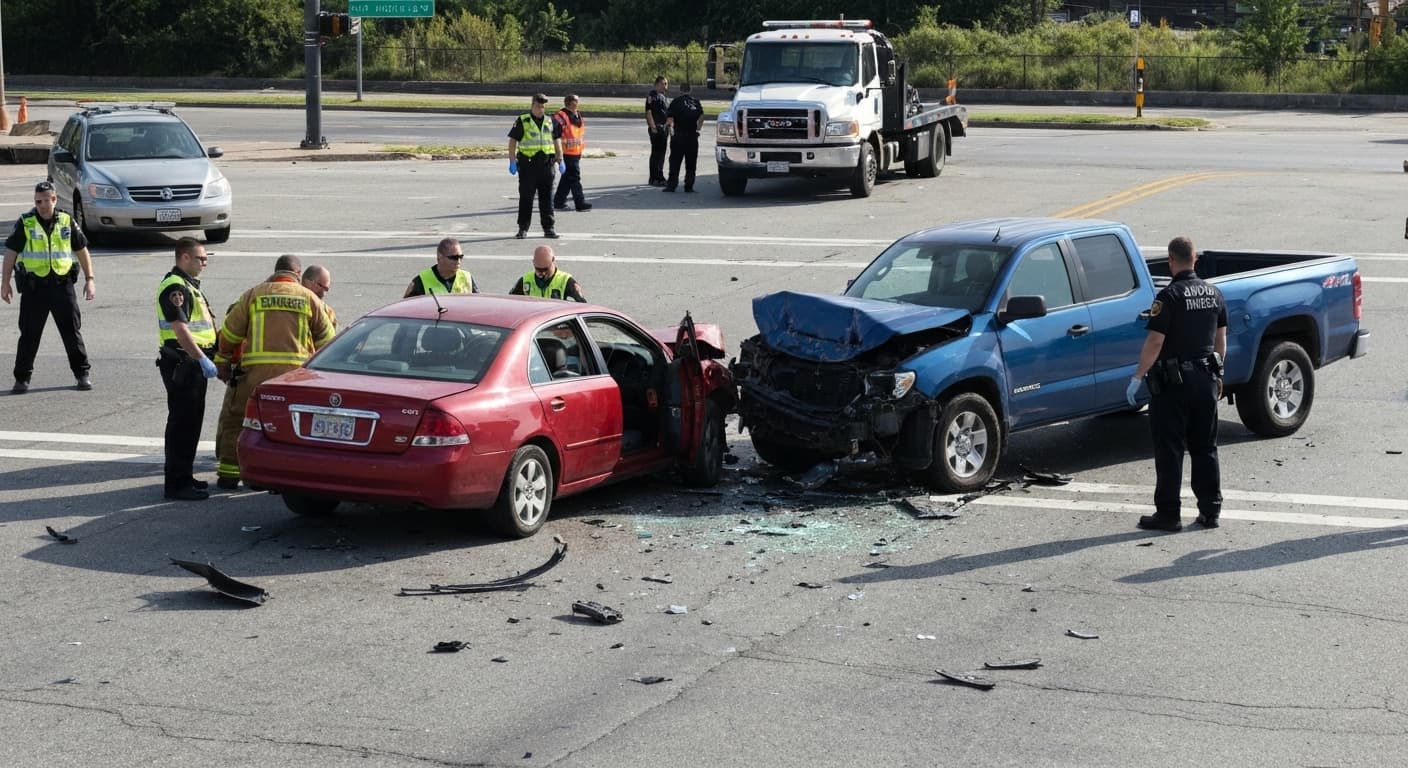
9 Documents You Need for Your Car Accident Case
Learn about 9 documents you need for your car accident case and how it affects your legal rights after a car accident. Get expert advice from experienced car accident attorneys.
# 9 Documents You Need for Your Car Accident Case
Building a successful car accident claim requires comprehensive documentation to prove liability, establish damages, and support your compensation request. Missing or inadequate documentation can weaken your case and reduce your chances of receiving fair compensation. Knowing which documents to gather and maintain can make the difference between a strong settlement offer and a denied claim. This guide covers the 9 essential documents you need for your car accident case, with explanations of why each document matters and how to obtain and organize them properly.
1. Police Accident Report
The official police report is the foundation document for any car accident claim, providing an objective account of the incident.
Report Content Importance:
- Official accident circumstances documentation
- Law enforcement officer observations recording
- Traffic violation citations and charges inclusion
- Witness statements collection and preservation
- Accident scene measurements and markings notation
Report Acquisition Methods:
- Immediate police department contact after accident
- Online portal access in many jurisdictions
- Walk-in retrieval at local police station
- Mail request submission with identification
- Third-party retrieval service utilization options
Report Enhancement Strategies:
- Officer contact information preservation for follow-up
- Additional detail requests if report seems incomplete
- Supplementary report filing if initial report lacks details
- Report accuracy verification and correction requests
2. Medical Treatment Records
Medical documentation provides crucial evidence of your injuries and establishes the connection between the accident and your health issues.
Essential Medical Documentation:
- Emergency room admission records and reports
- Physician consultation notes and treatment plans
- Diagnostic test results and imaging studies
- Prescription medication records and pharmacy documentation
- Rehabilitation therapy session records and progress notes
Record Organization Strategies:
- Chronological file organization and maintenance
- All healthcare provider visit documentation collection
- Treatment cost and billing statement preservation
- Medical release form completion for record access
- Follow-up appointment scheduling and attendance tracking
Medical Evidence Enhancement:
- Doctor statements linking injuries directly to accident
- Second opinion consultations for comprehensive documentation
- Pain management treatment records and effectiveness notes
- Functional limitation assessments and work restriction documentation
3. Accident Scene Photographs
Visual evidence of the accident scene, vehicles, and injuries provides compelling proof of the incidents circumstances and severity.
Comprehensive Photo Documentation:
- Wide-angle accident scene overview captures
- Vehicle damage close-up detailed photographs
- Road condition and environmental factor recordings
- Injury immediate aftermath visual documentation
- Skid mark and debris field photographic evidence
Photo Capture Best Practices:
- Multiple angle coverage ensuring comprehensive documentation
- Date and time stamp inclusion on all images
- Location metadata preservation for authenticity verification
- Before-and-after damage progression photographic series
- Weather condition documentation for context provision
Digital Photo Management:
- Secure cloud storage utilization for preservation
- Photo organization by category and chronology
- Backup copy creation and storage in multiple locations
- Metadata preservation for authenticity verification
- Professional photographer consultation for critical evidence
4. Witness Contact Information
Witness statements can provide unbiased accounts of the accident that support your version of events and establish liability.
Witness Information Collection:
- Immediate contact information gathering at accident scene
- Name, phone number, and email address documentation
- Relationship to accident parties disclosure recording
- Observation location and viewing angle notation
- Contact preference and availability time documentation
Witness Statement Acquisition:
- Written statement collection with detailed accounts
- Video-recorded testimony preservation for authenticity
- Follow-up contact scheduling for additional information
- Witness credibility assessment and documentation
- Corroborating detail verification across multiple sources
Witness Management Strategies:
- Professional statement taking service utilization
- Attorney-guided interview process implementation
- Witness availability tracking and coordination
- Subpoena preparation for court testimony requirements
- Backup witness identification for unavailable primary witnesses
5. Vehicle Repair Estimates and Bills
Repair documentation establishes the financial impact of property damage and supports your claim for compensation.
Repair Documentation Requirements:
- Multiple repair shop estimate collection and comparison
- Professional appraisal service engagement for accuracy
- Parts replacement cost and labor hour detail verification
- Salvage value determination and calculation inclusion
- Diminished value assessment completion and documentation
Cost Documentation Organization:
- Repair timeline and progress tracking maintenance
- Payment record and invoice preservation
- Warranty coverage information documentation
- Alternative repair option cost comparison preparation
- Total repair cost summary and breakdown compilation
Repair Evidence Enhancement:
- Pre-accident vehicle condition photographic documentation
- Maintenance record preservation for comparison purposes
- Comparable vehicle repair cost data collection
- Expert mechanical evaluation for hidden damage assessment
- Repair quality inspection and documentation
6. Insurance Policy Documents
Your insurance policy details are essential for understanding coverage limits, exclusions, and claim procedures.
Policy Documentation Essentials:
- Complete policy declaration page preservation
- Coverage limit and deductible amount verification
- Policy exclusion and limitation clause review
- Effective date and renewal information confirmation
- Named insured and covered driver list verification
Policy Information Access Methods:
- Insurance company policy document requests
- Current policy status online portal access
- Previous year policy document retrieval
- Endorsement and modification record collection
- State insurance department policy verification
Policy Analysis Importance:
- Coverage adequacy assessment for claimed damages
- Underinsured motorist coverage applicability determination
- Personal injury protection benefit availability confirmation
- Medical payment coverage limit identification
- Collision and comprehensive coverage verification
7. Employment and Income Records
Income documentation is crucial for calculating lost wages and establishing the financial impact of time away from work.
Income Documentation Types:
- Pay stub collection covering accident period
- Employment verification letter from employer
- Tax return copies for income history documentation
- Performance review and raise history preservation
- Workers compensation filing record maintenance
Lost Income Calculation Factors:
- Hourly wage or salary amount verification
- Overtime and bonus income documentation
- Sick leave and vacation pay accrual information
- Future earning capacity impact assessment
- Rehabilitation and return-to-work timeline evaluation
Income Evidence Enhancement:
- Employment contract and benefit plan documentation
- Performance bonus and commission record preservation
- Professional license and certification status verification
- Vocational rehabilitation assessment coordination
- Future income potential expert evaluation consideration
8. Accident-Related Expense Receipts
Detailed records of all accident-related expenses help establish the full financial impact and support compensation requests.
Expense Documentation Categories:
- Vehicle rental and alternative transportation costs
- Towing and vehicle storage expense records
- Medical transportation and ambulance service bills
- Prescription medication and medical supply costs
- Home modification and accessibility aid expenses
Receipt Organization Strategies:
- Expense categorization by type and chronology
- Receipt scanning and digital storage implementation
- Original document preservation in secure location
- Expense summary spreadsheet creation and maintenance
- Reimbursement status tracking and documentation
Expense Verification Methods:
- Cost reasonableness comparison with market rates
- Medical necessity documentation for treatment expenses
- Insurance coverage application verification
- Tax deduction eligibility assessment for qualified expenses
- Future expense projection for ongoing needs
9. Correspondence and Communication Records
Documentation of all communications related to the accident and claim process helps establish timelines and preserve important information.
Communication Record Types:
- Insurance company email and letter correspondence
- Phone call log with date, time, and summary notes
- Text message and social media communication preservation
- Attorney consultation notes and advice documentation
- Medical provider appointment and discussion records
Record Preservation Strategies:
- Centralized communication log creation and maintenance
- Digital communication archiving and backup systems
- Important conversation audio recording compliance
- Follow-up confirmation documentation practices
- Timeline reconstruction capability preservation
Correspondence Organization Methods:
- Chronological filing system implementation
- Communication type categorization and labeling
- Key information highlighting and reference system
- Backup storage in multiple secure locations
- Accessibility for legal counsel and case preparation
Document Collection and Organization Strategies
Systematic Documentation Approach
Immediate Post-Accident Actions:
- Accident scene evidence collection priority establishment
- Official report and police contact initiation
- Medical treatment documentation commencement
- Witness information gathering and organization
- Insurance company notification and documentation requests
Ongoing Documentation Maintenance:
- Regular file organization and review scheduling
- Missing document identification and acquisition
- New document addition and integration procedures
- Confidentiality and security measure implementation
- Legal counsel sharing and consultation coordination
Professional Assistance Integration
Attorney Documentation Support:
- Case file organizational assistance provision
- Missing document identification and collection guidance
- Evidence preservation strategy development
- Court admissibility requirement compliance assurance
- Document authentication and verification procedures
Expert Service Utilization:
- Accident reconstruction report preparation assistance
- Medical record interpretation and summary services
- Vocational rehabilitation assessment coordination
- Economic damage calculation professional services
- Court presentation preparation and organization
Digital Documentation Management
Electronic File Organization Systems
Digital Storage Solutions:
- Cloud storage service implementation for accessibility
- File naming convention establishment for easy retrieval
- Metadata addition for search capability enhancement
- Backup system creation for data preservation
- Version control implementation for document updates
Security and Privacy Measures:
- Password protection and encryption application
- Authorized access control system implementation
- HIPAA compliance for medical information handling
- Secure sharing protocols for attorney communication
- Data breach prevention and monitoring procedures
Legal and Evidentiary Considerations
Document Admissibility Requirements
Court Acceptance Standards:
- Chain of custody preservation and documentation
- Authentication procedure completion and verification
- Relevance demonstration for case connection
- Prejudice consideration and minimization
- Best evidence rule compliance and application
Evidence Preservation Obligations:
- Spoliation prevention and risk management
- Document retention schedule establishment
- Legal hold procedures for potential litigation
- Data backup and disaster recovery planning
- Archival storage solution implementation
Conclusion: Documentation Excellence for Case Success
Comprehensive documentation is the foundation of a successful car accident claim, providing the evidence needed to prove your case and maximize compensation. The 9 essential documents covered in this guide create a complete record that supports liability establishment, damages quantification, and fair compensation justification.
Effective document collection and organization demonstrates professionalism and thoroughness to insurance companies, attorneys, and courts. Starting immediately after the accident and maintaining systematic organization throughout the claims process ensures you have the strongest possible evidence foundation.
Remember that proper documentation can make the difference between a successful claim and inadequate compensation. Working with an experienced car accident attorney can help ensure you collect, organize, and present all necessary documentation effectively.
Most personal injury attorneys offer free initial consultations and work on contingency fees, meaning you pay nothing unless they win your case. Contact a qualified attorney today to help you gather and organize the essential documents for your car accident case.


